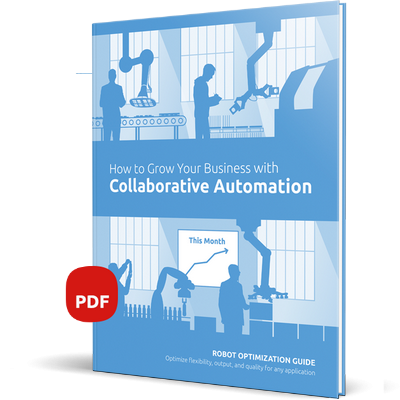Adapting to Crisis: Here’s why collaborative robot applications are key


Tim Rowley, Strategy Professor and Management Advisor, explains why automation using collaborative robot applications is key for manufacturers following the outbreak of COVID-19.
By Tim Rowley
Today, my daughter asked when she could go back to school. And yesterday, during a webinar with a group of manufacturing managers, I was asked when operations would be back to normal. I had the same empty feeling answering both questions: That dissatisfaction that comes from knowingly disappointing your audience.
The only honest answer to both questions was: “I really don’t know”.
Despite having lots of data, daily reporting by experts, and media predictions, there are too many possible futures to suggest one outcome is more likely than another. Indeed, I have seen equally confident experts suggesting different predictions: COVID-19 will be fully behind us by summer versus it will be with us in some form until 2022. There could be regional outbreaks in the fall or the winter or both. A vaccine will be available in 6 months. Or will it take 2 years? Making accurate predictions is a fool’s dream because, like 9/11 and Brexit, COVID-19 is a Black Swan – a highly unlikely and unique event that is difficult to foresee before it happens and brings with it drastic consequences. One of my data scientist friends said: “There is just too much noise to know what will happen next”.
This level of uncertainty is enough to make your head spin. Even the calmest among us might panic or freeze attempting to solve this problem. However, in my opinion, this is the wrong problem to solve: Asking when we will be back to normal or how will the impacts of COVID-19 play out over the next 18 months are not the right questions. The better question is:
How can we ensure operational stability in the face of possible labor disruptions brought on by future outbreaks?
We do not know the when, where, or how long of new outbreaks, but we must be prepared for this possibility. And now there is no excuse. Going forward, COVID-19 will not be a Black Swan event: It has turned into a big hairy problem right in front of us.
Managers are taking many steps to maintain operational stability and ensure employee safety. What is clear is that automation is the most effective step and that collaborative robot applications can be a solution to the COVID-19 problem in factory environments. We must adjust our mindset to think about ways to utilize labor more wisely and safely. And automation is essential for doing so. Let me share three reasons why automation using collaborative robot applications is key.
- Monitoring is not enough
As more factories move back into production (partial or full), new policies have been adopted, such as enhanced cleaning routines and daily employee temperature checks. Foxconn, which makes iPhones for Apple in China, has received attention for its practice of separating employees into 20 person groups, which work and live together and do not interact with any other groups. Some larger facilities have invested in contract tracing technologies, a practice adopted by several hospitals, to see how the virus might have spread.
While all these actions are useful, these steps are not enough to maintain operational stability. Separating working group helps to isolate infection spreads to smaller groups, but an infection will shut down the whole group. Temperature checks are minimally effective because infected workers can have no symptoms for two weeks, while they spread the virus.
And contact tracing tells us how many workers have been infected once one of them has been found to have the virus. These practices are mostly helpful for increasing employees’ comfort and understanding where the virus has spread. However, the horse has already left the barn, as the expression goes, and it has the virus.
- Social distancing is the key to labour and operation stability
The single most effective way to prevent the spread of the virus in factories and ensure operational stability is to create social distancing among workers. Social distancing is highly correlated with infection rates – countries that have implemented and followed strict social distancing practices have experienced the lowest infection rates and more quickly opened businesses – the poster child is Korea.
Factory spaces with multiple employees are super spreader environments, like weddings and bars – too many people near one another. Indeed, in many regions, infections hotspots have been in factories, such as the meat processing plants in the United States or densely populated factories in China that were shut down at the beginning of 2020.
Automation allows for thoughtful deployment of labor in ways that reduce close contact. Collaborative robotic solutions mean factory works cooperate with machines rather than other humans, leading to higher productivity and preventing virus transmission. Factories that have successfully created social distancing through smart collaborative automation are building better employee engagement and morale and will avoid costly government enforced shutdowns. - From labor intensive to labor smart processes
Through intelligent software and out-of-the-box tools, collaborative robot applications are accessible without automation experience. Automation is a path to social distancing and preventing the spread of COVID-19, while at the same time easy to deploy and operate.
Training systems can make it possible to quickly shift a task away from labor intensive to labor smart processes. Existing operators can quickly run the new systems, and payback for automation can be measured in weeks.
All in all, despite the many uncertainties, we must act. And in my view, automation using collaborative robot applications is the answer we are all looking for.
ABOUT THE AUTHOR
Tim Rowley
Professor of Strategy, University of Toronto
Visiting Professor, INSEAD, France
Management Advisor, OnRobot

|
Hur du utvecklar ditt företag med samarbetande applikationer
Med framväxten av smartare och mer anpassningsbara verktyg är det nu möjligt att driftsätta robotar med större hastighet, styrka, säkerhet och precision vilket gör att de kan utföra fler sorters uppgifter och maximera lönsamheten. Läs mer om hur du kan få snabbare produktion till lägre kostnad genom att hämta vår kostnadsfria e-bok.
HÄMTA DEN KOSTNADSFRIA E-BOKEN
|

|

